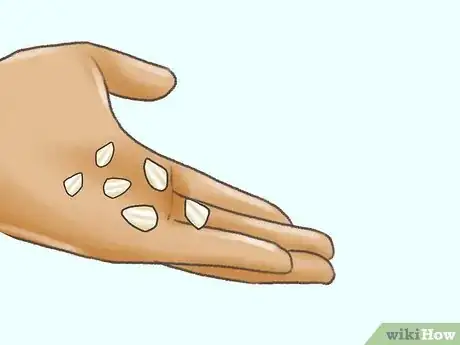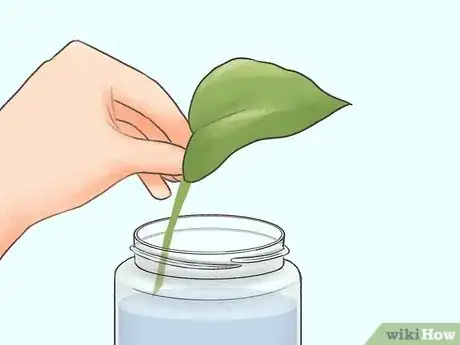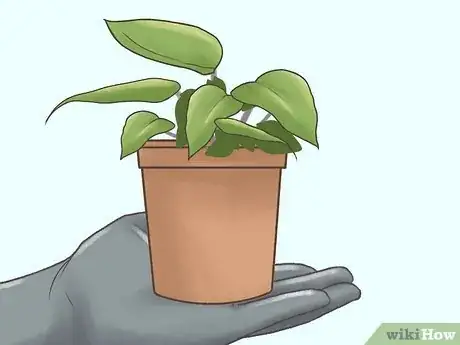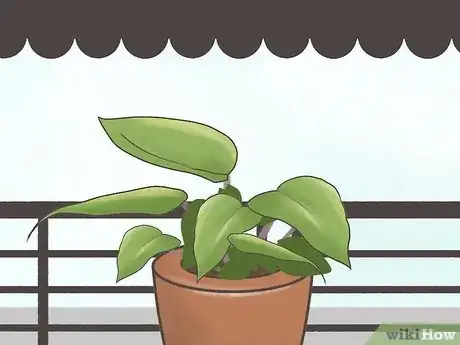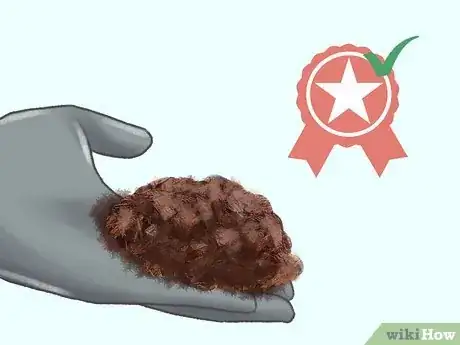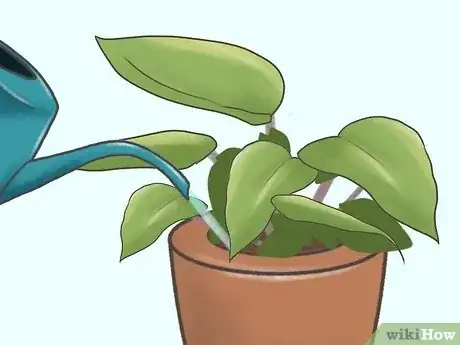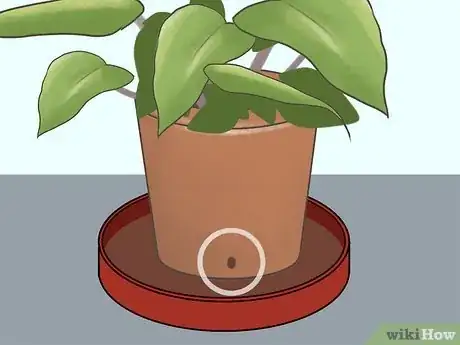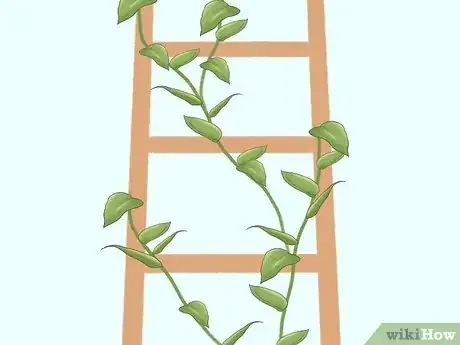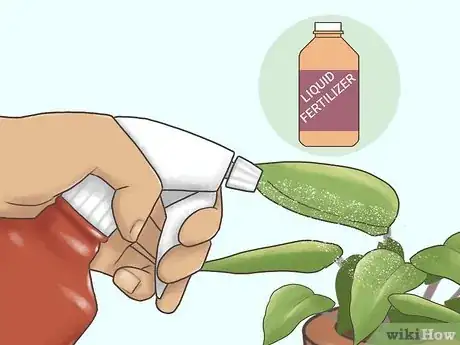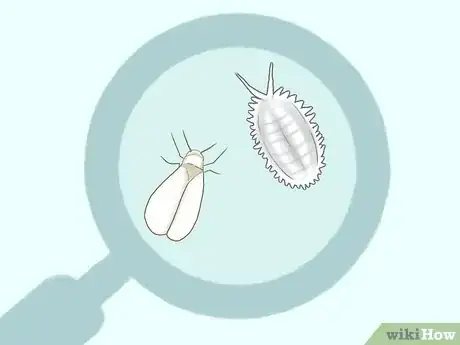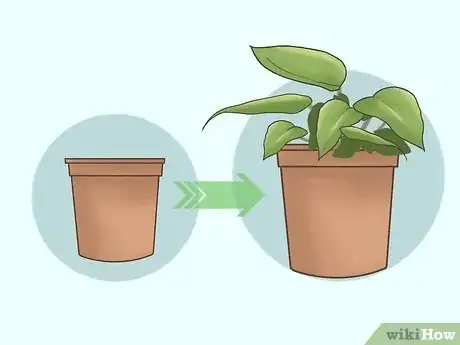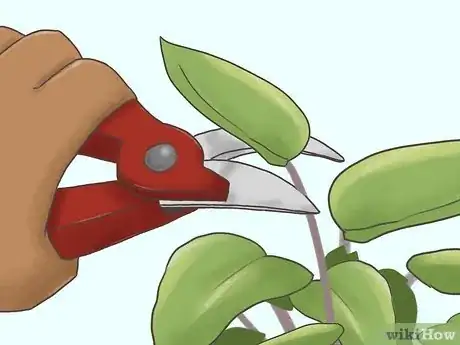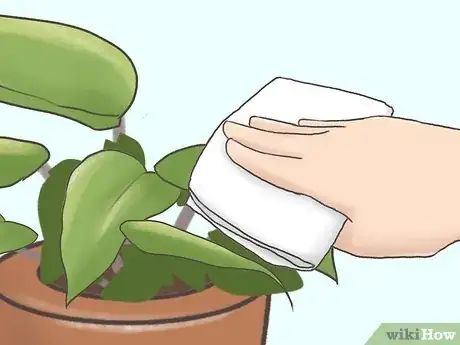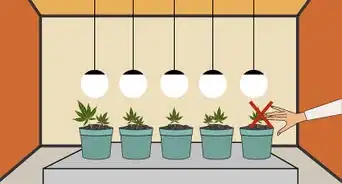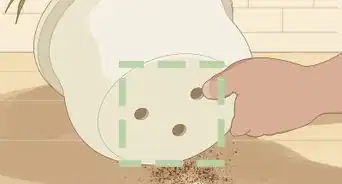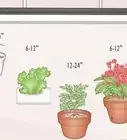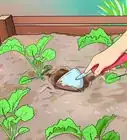This article was co-authored by Lauren Kurtz. Lauren Kurtz is a Naturalist and Horticultural Specialist. Lauren has worked for Aurora, Colorado managing the Water-Wise Garden at Aurora Municipal Center for the Water Conservation Department. She earned a BA in Environmental and Sustainability Studies from Western Michigan University in 2014.
There are 7 references cited in this article, which can be found at the bottom of the page.
wikiHow marks an article as reader-approved once it receives enough positive feedback. In this case, several readers have written to tell us that this article was helpful to them, earning it our reader-approved status.
This article has been viewed 124,180 times.
Philodendrons are vibrant plants that feature gorgeous foliage and bring a burst of nature to any home or outdoor space. They are especially easy to grow and take care of, which means they’re perfect plants for anyone who lacks a green thumb. By taking time to find the right plant, establishing some simple growing conditions, and offering it a little love year-around, your philodendron is bound to thrive.
Steps
Acquiring a Philodendron
-
1Start from seeds. It takes a long time to get a sizeable philodendron from a seed, but you can buy them from online gardening suppliers or personally collect them during blooming time. Put the seeds about 1/3 of an inch (1 centimeter) deep in nutritious breeding soil and cover them lightly. Spray the soil regularly to keep it moist.[1]
- Philodendron seeds do not need to be soaked prior to planting.
- The seeds will take about 2 to 8 weeks to germinate when the temperature of the soil is kept between 68 and 73 degrees Fahrenheit (20 to 23 degrees Celsius).
- When the seedlings sprout and become sturdy enough to handle, move each one to a small pot of its own to foster strong root development.
-
2Propagate from stem cuttings. If you know someone who has a healthy philodendron or you find one growing wild, you can take a stem cutting from it. Make sure to cut at least 3 inches (7.5 centimeters) below a joint in a leaf stem and remove lower leaves near the cut. Place the cutting in a jar filled with water near medium light. When roots appear, plant the cutting in a small pot with potting soil.[2]
- Orchid soil (with bark pieces) and a mixture of sphagnum peat and vermiculite or a mixture of sand and turf/compost can provide good nutrition for your newly planted cutting.[3]
- It’s important to keep the cutting watered regularly.
- Be sure there are drainage holes in the bottom of your pot, so that the cutting is protected from over-watering.
Advertisement -
3Air-layer from another plant. Air-layering can be used when the philodendron you want to propagate from is too mature or thick to cut. Start by cutting halfway through a mature branch at a 45 degree angle. Insert a small piece of plastic (like from a bottle) in the semi-cut, wrap the cut site with a moist ball of moss, and then wrap and tie the moss onto the stem using plastic wrap and string.[4]
- In about 2 weeks, you’ll see roots forming in the moss.
- You may need to tie the semi-cut branch to a support if it’s unable to support itself.
- Once you notice a healthy root system growing into the moss, you will be able to sever the stem about 1 inch (2.5 centimeters) from the air-layering site.
- Remove the plastic wrap and place the rooted moss ball into a small pot with rich soil. Make sure the pot has good drainage.
-
4Buy one from a greenhouse. If you want to enjoy a full-bodied philodendron right away, visit a local greenhouse and buy one there. There are many different varieties to choose from, and most of them aren’t expensive. Small philodendrons shouldn’t cost more than $10 USD, and they’ll come with their own custom care instructions.[5]
Creating the Right Conditions
-
1Provide shade and indirect sunlight. Philodendrons are native to rainforests and grow wild under towering treetops, so you’ll want to choose a place in your home that provides shade and indirect sun (8-10 hours per day) to mimic these conditions.
- If your plant is in a room without sun, you can create artificial light with a mixture of fluorescent and incandescent lighting.
-
2Use high-quality soil. A light-weight, nutritious soil provides the best growing conditions for philodendrons. You can enrich cheap garden soil by adding compost, worm castings, rotten leaves, coconut fibers, or flower soil.[6]
-
3Water regularly. You want to keep the soil moist at all times, but never soaking wet. An ample water supply is key to growing large, uniform leaves.[7]
- There is a common myth that philodendrons should be watered less in winter, but this is not true. Their native rainforests receive ample rainfall year around, so it’s important to mimic these conditions when you care for the plants.[8]
-
4Provide good drainage. Philodendron roots will rot if they get too wet, so make sure that your soil doesn't get too compact and that your pots always contain drainage holes. To fix excessive compaction, gently knead and fluff the soil with your hands to add air and break up soil clumps.
-
5Monitor the temperature and humidity. Philodendrons are native to temperate climates, which means they do best in warm, humid weather. The ideal temperature for a philodendron is about 65 degrees Fahrenheit (18 degrees Celsius) with 60% humidity. To increase humidity, you can use a small humidifier, group houseplants together, or place your plant on top of a tray filled with pebbles and water.
- The plants are adaptable to temperature fluctuation and can survive in temperatures as low as 55 degrees Fahrenheit (13 degrees Celsius), but they cannot survive frost or freezes.[9]
- You can buy temperature and humidity monitors at most garden centers.
-
6Let it creep. A well-cared for philodendron can grow up to 10 feet (3 meters) in height. In order to reach that height, many types of philodendrons need to climb and creep up something sturdy for support, so make sure you place the plant within touching distance of a beam or pole.
- You can also place tree branches or moss sticks right in the pot to facilitate climbing.
Providing Long-Term Care
-
1Fertilize 5 to 6 times a year. Philodendrons need nutritious soil. Liquid fertilizer is a great food source, but be sure to follow the directions and use the weakest dilution that is specified on the label. Because philodendrons don’t get direct sun, they can’t process strong fertilizer.
- If your plant is exposed to varied seasonal sunlight, you’ll want to fertilize a little more often in the fall and winter months. This will keep growth steady.
- As your plant grows bigger, you’ll want to switch to a fertilizer with increasing amounts of nitrogen to support broad, green leaf growth.[10]
-
2Watch for signs of sickness. If you notice yellow patches or sunburn spots on the leaves, your plant is getting too much direct sunlight. If your leaves turn brown and fall off, you are using too much fertilizer. If the leaves start to yellow, you are watering too much. Wilting leaves mean that you need to water more.
- Spider mites, mealy bugs, scale insects, and thrips are pests that can damage your plant. If you notice them, try wiping them away with a mild soap, luke-warm water, and a soft cloth.[11]
-
3Re-pot annually. As your plant grows, it will need a bigger pot to live in. Philodendron roots prefer a bit of cramping, though not excessive cramping. When you notice your plant’s roots begin to compact into a ball, it’s time to move the plant into a pot that is 2 to 3 inches (5 to 7.5 centimeters) larger.[12]
- Repotting should be done before the plant experiences new growth. Each plant will be different and growth habits will be dependent on where you live, but it’s usually best to re-pot in late winter or spring.
- Monitor water levels closely after a re-potting. You don’t want the roots to dry out in the new soil space.
-
4Prune it during periods of slow growth. If you notice your plant’s growth slowing, it is a good time to prune it. Using pruning shears, trim rotted roots and any areas on the plant where you see stunted growth. You can also trim tips of the plant to achieve a shorter, more-desirable height.[13]
- To access the roots for pruning, de-pot the plant and gently remove any clinging soil. The best time to prune roots is when you are moving the plant to a larger pot.
-
5Keep your plant clean. Many people keep their philodendrons indoors and the leaves can collect dust and clog their pours. Be sure to keep your plant clean and dusted with a soft, damp cloth.
Expert Q&A
Did you know you can get expert answers for this article?
Unlock expert answers by supporting wikiHow
-
QuestionHow should the plant be cared for when exposed to freezing temperatures?
 Lauren KurtzLauren Kurtz is a Naturalist and Horticultural Specialist. Lauren has worked for Aurora, Colorado managing the Water-Wise Garden at Aurora Municipal Center for the Water Conservation Department. She earned a BA in Environmental and Sustainability Studies from Western Michigan University in 2014.
Lauren KurtzLauren Kurtz is a Naturalist and Horticultural Specialist. Lauren has worked for Aurora, Colorado managing the Water-Wise Garden at Aurora Municipal Center for the Water Conservation Department. She earned a BA in Environmental and Sustainability Studies from Western Michigan University in 2014.
Professional Gardener
-
QuestionThe leaves on my philodendron are small and not full like when I bought them. What can I do to make the leaves fuller and bigger?
 Lauren KurtzLauren Kurtz is a Naturalist and Horticultural Specialist. Lauren has worked for Aurora, Colorado managing the Water-Wise Garden at Aurora Municipal Center for the Water Conservation Department. She earned a BA in Environmental and Sustainability Studies from Western Michigan University in 2014.
Lauren KurtzLauren Kurtz is a Naturalist and Horticultural Specialist. Lauren has worked for Aurora, Colorado managing the Water-Wise Garden at Aurora Municipal Center for the Water Conservation Department. She earned a BA in Environmental and Sustainability Studies from Western Michigan University in 2014.
Professional Gardener You should be fertilizing your philodendron monthly during the spring, summer and fall with a liquid fertilizer, high in nitrogen. Use a diluted strength more frequently rather than a concentrated dose less frequently. Also make sure you are consistently watering your plant. The soil should always be moist.
You should be fertilizing your philodendron monthly during the spring, summer and fall with a liquid fertilizer, high in nitrogen. Use a diluted strength more frequently rather than a concentrated dose less frequently. Also make sure you are consistently watering your plant. The soil should always be moist. -
QuestionHow do I grow a philodendron from a cutting?
 Community AnswerPrepare a pot with good fertilizer released soil. Cut a long piece of philodendron stem, with or without leaves. Place the cutting on top of the soil in a circle, following the shape of the pot. Press firmly into the soil for good contact. The cutting will root everywhere there is a node on the stem.
Community AnswerPrepare a pot with good fertilizer released soil. Cut a long piece of philodendron stem, with or without leaves. Place the cutting on top of the soil in a circle, following the shape of the pot. Press firmly into the soil for good contact. The cutting will root everywhere there is a node on the stem.
References
- ↑ https://www.plantopedia.com/philodendron/
- ↑ https://davesgarden.com/guides/articles/view/3437
- ↑ https://www.plantopedia.com/philodendron/
- ↑ http://www.epicgardening.com/air-layering/
- ↑ http://www.thegardenhelper.com/philodendron.html
- ↑ https://www.plantopedia.com/philodendron/
- ↑ http://www.ladybug.uconn.edu/FactSheets/philodendron----.php
- ↑ http://www.ladybug.uconn.edu/FactSheets/philodendron----.php
- ↑ https://www.caringforhouseplants.com/guide-to-growing-philodendrons/
About This Article
To grow a philodendron, either plant seeds or take a cutting from a healthy plant. Plant the philodendron in a pot filled with high-quality growing soil, and place the container plant in an area with shade and indirect sunlight. Water the plant regularly to keep the soil moist at all times, but don’t get the soil too wet or the roots will rot. Since philodendrons are from the rainforest, they prefer temperatures around 65°F, and they will not survive frost or a freeze. Keep reading to learn tips from our horticulture reviewer on long-term philodendron care, including how often to fertilize it!
